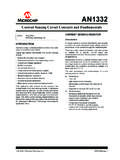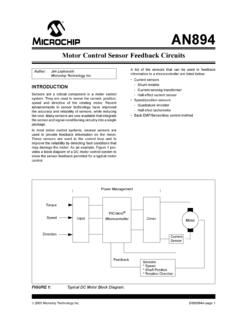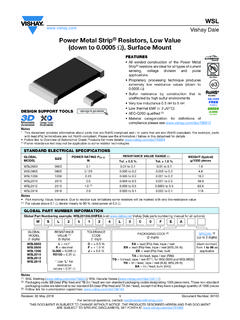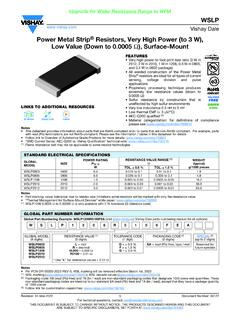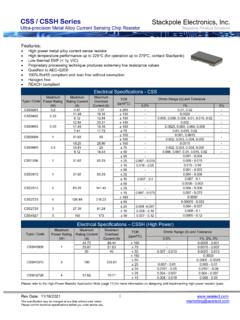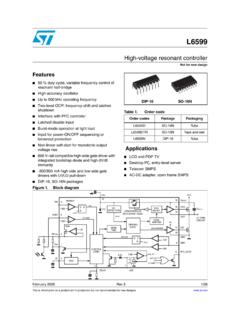Transcription of AN5306 Introduction Application note - STMicroelectronics
1 AN5306 . Application note Operational Amplifier (OPAMP) usage in STM32G4 Series Introduction The operational amplifier (OPAMP) embedded in the STM32G4 Series device extends the analog capabilities of the microcontroller. This Application note describes how to implement an OPAMP to support a number of analog applications using a minimum number of external components and outline the OPAMP configuration using the digital controls. This Application note explains how to implement the OPAMP in a number of operating modes and outlines some specific practical examples. AN5306 - Rev 1 - May 2019 For further information contact your local STMicroelectronics sales office.
2 AN5306 . General information 1 General information This document applies to the STM32G4 Series Arm -based microcontrollers. Note: Arm is a registered trademark of Arm Limited (or its subsidiaries) in the US and/or elsewhere. AN5306 - Rev 1 page 2/43. AN5306 . What is an OPAMP basics. 2 What is an OPAMP basics. OPAMP operation basics Figure 1. Basic OPAMP representation Non inverting input + OUTPUT. Inverting - +. input The operational amplifier is an analog device that amplifies differential input signals (difference between inverting and non-inverting input) to give a resulting output voltage. Figure 1. Basic OPAMP representation illustrates the circuit representation of an OPAMP.
3 The ideal operational amplifier must have the following properties: Infinite amplification gain (open loop). Infinite input impedance Zero output impedance Infinite frequency bandwidth Zero input offset voltage If the OPAMP has infinite gain, then the differential signal at input must be zero (in closed loop linear operation)- because the gain is infinite and output voltage is at finite level: Uout = Uin x Gain = 0 x = finite voltage. This basic idea (input voltage at zero) simplifies the OPAMP usage in real applications . Real operational amplifier requires properties close to ideal requirements: High amplification gain (open loop) for example: gain = 1,000,000 (120 dB).
4 High input impedance for example Zin = 100 M . Low output impedance for example Zout = 10 . High frequency bandwidth for example f-3 dB = fGBW = 10 MHz (for closed gain loop = 1). Low input offset voltage for example Uoffset = 1 mV. AN5306 - Rev 1 page 3/43. AN5306 . OPAMP in practice operation example OPAMP in practice operation example The ideal OPAMP has infinite gain. This means that if output needs to be set at a defined value then the input differential signal should be zero. The output signal should influence input differential voltage through negative feedback to balance the operation point. Figure 2. Inverting amplifier by using OPAMP below illustrates an example of an inverting amplifier setup: Figure 2.
5 Inverting amplifier by using OPAMP. R1 R2. I1 I2. Uin Idiff - Udiff Uout +. A voltage is applied to Uin on the negative OPAMP input of Udiff through R1 resistor . This increase on the negative input causes a voltage decrease on Uout due to the OPAMP gain ratio. Then the Uout voltage causes a decrease of the voltage on the negative OPAMP input through R2 resistor this is the negative feedback set up on Uin. The feedback then stabilizes the differential voltage of the OPAMP input (Udiff) to reach zero and the Uout voltage reaches the required level (Uout = Udiff x ). If Udiff is zero then Uout voltage is calculated based on Uin using the following formulas: Udiff = 0 V (zero differential voltage).
6 Idiff = 0 A (zero current on the OPAMP input because input impedance is ). I1 = Uin / R1 (current through R1, because Udiff = 0 and non-inverting OPAMP input is grounded). I2 = Uout / R2 (current through R2, because Udiff = 0 and non-inverting OPAMP input is grounded). I2 = -I1 (because Idiff = 0). Uout / R2 = -Uin / R1. Uout = -Uin . (R2/R1). The final circuit gain is calculated as a ratio between the output and the input voltage (gain = Uout/Uin). Final gain is given here only by external resistors values of R1 and R2 and is not depend on the OPAMP (if its gain is ). AN5306 - Rev 1 page 4/43. AN5306 . Brief description of the OPAMP in the STM32G4 Series 3 Brief description of the OPAMP in the STM32G4 Series The STM32G4 Series integrates OPAMPs that can be used in high speed analog to digital applications as analog signal pre-conditioning for ADC data sampling or as standalone amplifiers.
7 Main Application areas are: Motor control applications (current and voltage sensing ). Digital switched-mode power supplies DSMPS (current and voltage sensing , control loop). Light control applications (current and voltage sensing ). Analog sensors measurement applications (thermometers, low signals measurement and so on). Medical applications (analog signals sensing /amplification). Audio applications (signal amplification). General purpose analog signal usage (oscillators, comparators and so on). OPAMP parameters Basic performance parameters of the STM32G4 Series operational amplifier are: Input voltage offset: approx.
8 +/- 3 mV (after built-in calibration of offset). Bandwidth: approx. 13 MHz Slew rate: Normal mode: approx. V/ s High speed mode: approx. 45 V/ s. Output saturated voltage: less than 100 mV (rai-to-rail). Gains: Positive: +1, +2, +4, +8, +16, +32, +64. Negative: -1, -3, -7, -15, -31, -63. Typical gain error: 2%. Open loop gain: ~ 95 dB. Wakeup time: 3 s. AN5306 - Rev 1 page 5/43. AN5306 . OPAMP connections OPAMP connections The OPAMP in STM32G4 Series works across several operational configurations. The OPAMP configuration is defined using a set of analog multiplexers which interconnect the OPAMP input and output terminals through an internal resistor network.
9 Final gain of this programmable gain amplifier (PGA) is defined by the resistor ratios on the feedback. Figure 3. Internal OPAMP connections in STM32G4 Series illustrates the basic schematic of the OPAMP. integrated in STM32G4 Series. Figure 3. Internal OPAMP connections in STM32G4 Series STM32G4 Series OPAMP. VINP0. VINP1. VINP2. + Opamp_. out VINP4 or DACx_CHy VINM0. VINM1. - VOUT. AN5306 - Rev 1 page 6/43. AN5306 . Simple examples of OPAMP configuration Simple examples of OPAMP configuration Inverting amplifier Basic schematic of a general inverting amplifier is illustrated in Figure 4. Inverting amplifier using an OPAMP.
10 Figure 4. Inverting amplifier using an OPAMP. R1 R2. I1 I2. Uin Idiff - Udiff Uout +. To implement this setup using the STM32G4 Series, configure the multiplexers as shown in Figure 5. Inverting amplifier implementation by OPAMP in the STM32G4 Series. Connect the analog input signal to VINM0 OPAMP. pin. Connect the reference ground to VINP0 OPAMP pin. The internal feedback resistors define the gain. The gain is set in the OPAMP configuration registers to: -1, -3, -7, -15, -31 and -63. Figure 5. Inverting amplifier implementation by OPAMP in the STM32G4 Series STM32G4 Series OPAMP. VINP0. VINP1. VINP2 + Opamp_out VINP4 or DACx_CHy VINM0.











